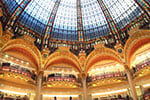The perfect temperature for Mona Lisa
With its international reputation for art, architecture, food, fashion and nightlife, some say Paris is the coolest place on earth. And one of the companies helping it stay that way is Climespace, which supplies air-conditioning via a 52 km underground network.
DATE 2023-11-28 AUTHOR Anna McQueenThe perfect temperature for Mona Lisa
“In a city like Paris, a network like ours has huge advantages over individual air conditioning systems,” explains Bertrand Martin, General Manager of Climespace. The company was created in 1991 as a venture between Gaz de France and the Suez group and serves 460 buildings in the French capital, including such prestigious addresses as the Louvre museum, the Paris Opera, the Forum des Halles, the Banque de France, the Galleries Lafayette and the Ritz hotel.
 Climespace applies the concept of district cooling, using a central source to supply a number of buildings instead of having individual systems for each building. “Many of our clients are located in buildings of particular historic and architectural value and would thus be prohibited from installing individual air-conditioning units on the buildings themselves,” explains Martin. “And what’s more, the price of real estate is such that in Paris, the cost of the space needed for an individual installation is often prohibitive,” he adds.
Climespace applies the concept of district cooling, using a central source to supply a number of buildings instead of having individual systems for each building. “Many of our clients are located in buildings of particular historic and architectural value and would thus be prohibited from installing individual air-conditioning units on the buildings themselves,” explains Martin. “And what’s more, the price of real estate is such that in Paris, the cost of the space needed for an individual installation is often prohibitive,” he adds.
Using the Climespace solution represents a significant space-saving exercise freeing up roof space for terraces for example. The system is also cheaper in terms of operation and maintenance, and presents significant tax advantages for the client.
The Climespace system also offers important benefits in terms of energy savings: “Besides, we have estimated that a building using our system creates 20% less carbon dioxide emissions and 30% less refrigerant leakage compared to one using an individual air conditioning system,” says Martin. Furthermore, the Climespace solution makes no noise or vibration, unlike traditional systems. Climespace also guarantees the exclusion of any risk of bacterial contamination, another important advantage.
Biggest network in the western world
 Each building is served by a totally automated, intelligent delivery sub-station connected to the Climespace network of six district cooling plants through Paris’s sewerage system along two separate pipe networks, one bringing the cold water (supply pipe), and the other sending back the heated water (return pipe).
Each building is served by a totally automated, intelligent delivery sub-station connected to the Climespace network of six district cooling plants through Paris’s sewerage system along two separate pipe networks, one bringing the cold water (supply pipe), and the other sending back the heated water (return pipe).
The district cooling plants are hidden beneath Paris. Three of them – under the Palais de Tokyo (presently under construction), the Place du Canada and another at Bercy – are unique in that they use water taken directly from the Seine. The other three at Les Halles, the Opera and at Place de l’Étoile use a cooling tower to refrigerate and are used only during the summer when demand is high. Climespace also has three storage facilities, two ice storage tanks and one chilled water storage tank, in reserve for peak load periods.
As the biggest district cooling network in the western world and the only provider of this kind of service in Paris, Climespace is in high demand, but this poses its own problem: “It’s very hard to find 2,500m2 of free space in central Paris – even underground –in which to install another station,” smiles Martin.
All the district cooling plants have their own generators to guarantee constant service. They are all linked and controlled remotely from a centre at Les Halles, where all client data is centralized. Fourteen people work in shifts around the clock to manage the plant and a network of technicians is on stand-by to intervene wherever and whenever necessary.
A simple iron door on the quayside next to where tourists pick up the bateaux mouches by the Pont des Invalides is the only indication of the Canada refrigeration station, the largest on the network, descending through five floors to 25 metres under the river.
The river water is pumped into the station and filtered to remove foreign objects before passing through a heat exchanger in the cooling liquid circuit. The cooling liquid then passes through a refrigeration unit containing a condenser and evaporator, which chills the water in the air-conditioning circuit. The water is then pumped away to the individual clients.
“All the circuits are closed so there’s no risk of bacterial contamination or steam emissions,” explains Eric Mimouni, manager of the Canada station.
Using river water saves some 500,000m3 of drinking water every year. “And we provide an extra service as the water we send back into the Seine is cleaner than when it came in,” says Mimouni.
Cooperation extended step by step
“Ours is a mission of excellence and our clients are looking for quality,” explains Martin. “With customers like the Louvre museum using Climespace to ensure their works of art are kept at the correct temperature, and some of the best restaurants in the world needing to be confident their foie gras won’t melt, we need partners we can rely on and that’s why we work with Alfa Laval.”
“We were using different brands of heat exchanger in each sub-station but we soon realized this made things less efficient,” explains Franck Benassis, in charge of the sub-stations department at Climespace. “In 1993 we signed a 3-year contract with Alfa Laval to supply the plate heat exchangers for 100 sub-stations,” he adds.
In 1995 Climespace decided they wanted to find a supplier that could develop a standardized concept and offer complete sub-station units rather than just the heat exchangers. Alfa Laval won three further contracts to supply these. “The contract was more of a partnership agreement rather than a supplier-client relationship,” explains Benassis.
“In 2004 we began to look for a company capable of offering a total concept from the supply of new equipment to its installation and maintenance,” explains Bertrand Guillemot, production manager at Climespace. “We are used to working with companies capable of offering a part of what we need, but Alfa Laval was the only company capable of supplying a complete solution,” he adds.
“We spent 18 months working together on a new contract which we signed in December 2005,” says Martin. In the new contract, Climespace included a number of requirements in terms of quality, speed of response, performance and price, relating to new products as well as service and maintenance of existing equipment. The contract also comprises engineering support for further development.
Mutual trust, mutual benefits
“For us, it’s a completely new way of doing business,” says Franck Bardini, sales manager of Alfa Laval Parts & Services in France. “It’s a perfect example of added customer value that will be crucial for Alfa Laval in the future.”
Martin stresses that the contract really works in practice and that it is not simply an agreement between company directors but the result of long discussion between the people who will be doing the work. “Our partners must know Climespace and our operations inside out and they must share our concerns about customer service. Alfa Laval has responded to all those needs,” he says.
“Together we’re creating a constantly forward-moving dynamic with a close cooperation between our teams,” says Bardini. “We integrated 150 hours of research into the contract to reengineer the sub-stations which will bring significant savings for Climespace and increase the efficiency of Alfa Laval’s solutions. This is the first step of the mutually enhanced profitability we believe will be created by this partnership.”
“We need to trust that our suppliers know what’s best for Climespace,” says Benassis. “Ours is a relationship which will develop – there’s no question of it remaining static. Now Alfa Laval must simply rise to the challenge.”
